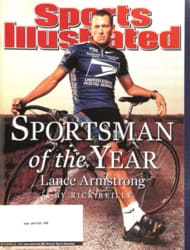
Inside Out NEWS AND NOTES FROM THE WORLD OF ADVENTURE SPORTS
The Drop Zone
Expanding the frontier of first descents, a heli-skiing
company is opening up the Himalayas to downhillers
Imagine yourself standing in skis at 18,000 feet watching the
chopper veer away toward the down-mountain rendezvous zone. The
morning air is thin, clear, cold. The slopes below are wide-open,
treeless and range from gentle to gnarly. You are on one of the
four Annapurna sisters, mountains whose 26,000-foot peaks loom
above you. Maybe this afternoon, depending on how you feel and on
the snow conditions, you'll take the helicopter 200 miles east
and ski Everest.
Tighten your bindings. This winter, for the first time, you can
heli-ski the Nepalese Himalayas. Himalayan Heli Ski Guides (HHSG)
will take its first clients into this cathedral of peaks between
mid-January and April. "Nearly every run will be a first
descent," says HHSG director Craig Calonica, a 49-year-old
adventurer and former professional speed-skier who has been
climbing in the Himalayas for 22 years. He has been up Everest
twice with the ambition of skiing it from top to bottom, and
though storms have kept him from reaching the summit, he says his
time in the Himalayas has always made him wonder what it would be
like to have a helicopter to scout those mountains and open ski
slopes. "The possibilities are endless," he says. "We've only
just nicked the bare edge of it in the Annapurna region, but
we're hoping to open other areas every season. It's like finding
the Alps before anybody skied them."
While these days you can heli-ski mountains from Greenland to New
Zealand, the addition of the Himalayas has even veterans of the
sport whirling. "I'd love to go, take some groups in with their
outfit," says Dean Cummings, owner and guide for Dean Cummings's
H20 Guides, which has been running Alaskan ski tours for eight
years. "It's exciting that they're going to provide a way to use
those mountains with minimal environmental impact--no roads, no
discarded oxygen bottles. They're going to fly in and leave
nothing but tracks."
Calonica and his three guides, Stephan Dan, Dede Rhem and Jerome
Ruby, all former ski-racing and snowboard professionals from
Chamonix, France, made their first scouting trip last March,
choppering into the Manang region, which lies on the north side
of the Annapurna range. They began most of their runs at around
18,000 feet and finished 10,000 feet below. "We had perfect
conditions," Calonica says of that trip. "Everything from
knee-deep powder to windblown to hard pack to spring snow and
every terrain from flat to rolling to as steep as you want. It
was amazing to stand there in the shadow of these incredible
peaks picking your line down a slope that no one had ever put a
line on before."
HHSG plans to scout and open Everest-area slopes soon (weather
permitting), as well as slopes in the Dolpo region, which borders
Tibet in northwestern Nepal and was until 1989 closed to Western
tourists. "Dolpo could be one of our best areas," says Calonica,
"because it gets the best snow in the country and has endless
miles of wide-open mountains for ripping or just plain cruising.
But we have permission to scout the whole country, so there's
really no limit to what we might find."
Clients (who, as a reminder in the company's brochure puts it,
should be "accomplished skiers in fit shape") can choose from
one-week, 10-day or two-week itineraries, with accommodations at
local inns or in tents at a fully equipped base camp manned by
Sherpas. The camp will be stocked with medical equipment,
including oxygen and a decompression chamber.
"Skiing is a risk sport," says Calonica, "and heli-skiing adds to
that. But our guides all have extensive avalanche security
experience, and we'll be checking the runs every morning." So
that you can check them out for the rest of the day.
--Craig Vetter
Prices and schedules can be obtained by emailing Calonica at
himalheli@easyconnect.fr.
INDOOR ADVENTURE
As we approach the 50th anniversary of Sir Edmund Hillary's
historic Everest climb, a TV documentary shines the light on
another thin-air giant
Wednesday 12/18
Outdoor Life Network, 9 pm, Messner
It's a lonely ether mountaineers occupy, even one as accomplished
as Reinhold Messner, for whom the label "the Michael Jordan of
his sport" has been commonly invoked so that the planet's
nonclimbers might better appreciate him. Messner himself has done
his part to ensure that his towering feats aren't so easily
overlooked, having written more than a dozen books on his
fascinating career. This hourlong documentary serves as a
CliffsNotes on the Messner oeuvre, tracing a passion for climbing
that began in Italy's South Tyrol in 1949, when Reinhold was
five; survived the death of his brother, Gunther, during their
first Himalayan expedition, in 1970; and drove him 10 years later
to pull off an unprecedented solo ascent of Mount Everest without
supplemental oxygen, widely considered to be mountaineering's
greatest feat.
While Sir Christian Bonington and Ed Viesturs offer enlightening
commentary on their fellow thin-air colossus, the documentary
relies largely on the colorful, if sometimes rambling, voice of
Messner himself, who is characteristically not shy about buffing
his legend. These stem-winding soliloquies consume valuable
minutes that might have been better used to address some of the
less flattering elements of his biography, such as his
oft-ridiculed insistence that he once saw a yeti (a Himalayan
abominable snowman), a claim for which he was unable to furnish
any proof. Still, the remarkable tale of mountaineering's Michael
is one worth revisiting--if for no other reason--simply because
it is there.
For Real
Avid male mountain bikers received a bit of butt-puckering news
last week when a study suggested that all that stump jumping may
greatly increase their chances of infertility. Conducted by a
team of Austrian scientists, the study found that 90% of the
bikers tested--all men who logged more than 3,000 miles a
year--had a lower sperm count and less mobile sperm than a group
of noncyclists. In 1999 the same team found that mountain bikers
were far more likely to have scrotum irregularities, such as
cysts and calcifications, than noncyclists. Not every doctor,
though, is buying the new study. "The theory is there," says Dr.
Sangili Chandran, a sports medicine specialist. "The proof I'm
still looking for."
Statitude
3
Winters since the Men Who Ride Mountains Big Wave Contest at
Maverick's has been held. As Jaws was enjoying its most ferocious
swells in a decade, the once-venerated Maverick's contest--which
has been postponed the last two seasons because of
less-than-ideal conditions--was looking for a new sponsor in
hopes of a revival in 2003--04.
Good Surf
For more adventure, go to siadventure.com and check out these
features:
--Five sweet North American heli-skiing destinations
--Flashback: SI's coverage of the 2002 Paris-Dakar rally
--Link to SKI Magazine's 2002 buyer's guide
COLOR PHOTO: JAMES LOZEAU
COLOR PHOTO: GALEN ROWELL/MOUNTAIN LIGHT BIG SISTERS At 26,000 feet, the Annapurnas offer adventurousskiers heady challenges.
COLOR PHOTO: ORGLIA FRANCO/CORBIS (MESSNER)

